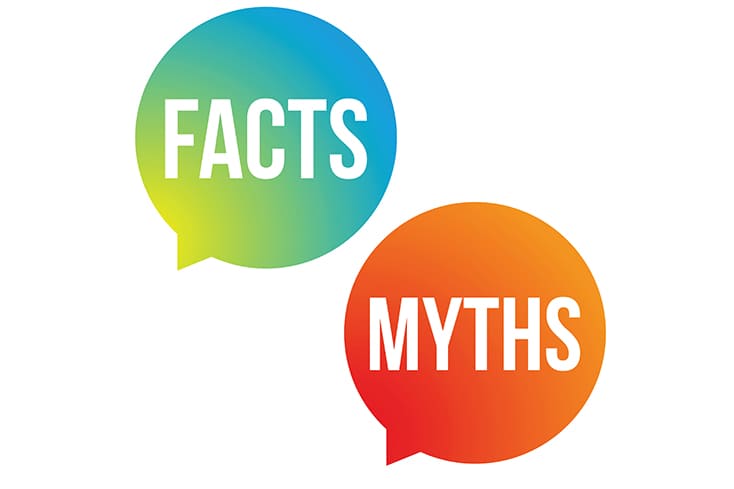May 05, 2021
By Cassandra Miasnikov

While the media is doing a better job today of depicting bipolar disorder, such as in shows like “Euphoria,” “Homeland” and “Modern Love,” there are still many misconceptions when it comes to understanding this mood disorder.
All of us experience ups and downs throughout a given year, but for people with bipolar disorder, these peaks and valleys are much more severe — from the highs of mania to the lows of depression. Unlike typical mood swings that pass quickly, bipolar disorder features cycles or episodes that lasts from weeks to months.
Since bipolar disorder often worsens without treatment, it’s essential to learn what the symptoms look like to reduce stigma and encourage people to seek help.
Fact: Bipolar disorder is more common than you might think: 2.8% of U.S. adults experienced bipolar disorder in the past year.
Researchers have not discovered a single cause of bipolar disorder. Currently, they believe several factors may increase the risk of developing bipolar disorder or can act as a trigger for the first episode:
Fact: According to the Diagnostic and Statistical Manual (DSM-5), there are seven types of bipolar disorder:
Fact: The extreme highs and lows of bipolar disorder are vastly different from mood swings or moodiness. People with bipolar disorder experience severe changes in energy, activity and sleep.
While people with bipolar disorder do experience extreme highs and lows, these are very different from the mood fluctuations we all experience. Waking up happy, getting exhausted and irritable midday and having a good evening that leaves you feeling happy again doesn't mean you have bipolar disorder. It doesn't matter how often this happens to you. Even a diagnosis of rapid-cycling bipolar disorder requires several days in a row of manic/hypomanic symptoms, not just several hours.
Clinicians look for groups of symptoms, not just emotions. The hallmark highs and lows of bipolar disorder are extreme, often occur out of context and last for extended periods of time. This experience can be debilitating and often requires hospitalizations.
Fact: Bipolar disorder features a wide range of mood disturbances, including mania, hypomania and depression.
A person must have experienced at least one episode of either mania or hypomania in order to be diagnosed with bipolar disorder. However, not all people with bipolar disorder experience the same symptoms. Most experience different types and at different severities.
According to the APA's Dictionary of Psychology, mania is a state of over-activity, excitement and psychomotor agitation. This state of noticeably elevated mood can also result in severe disruption to one's daily life. Mania is often accompanied by grandiosity, over-optimism or impaired judgment. Mania can also feature psychotic symptoms like hallucinations or delusions, which can cause a sense of detachment from reality.
Hypomania is a less severe form of mania, which features increased energy, activity and mood.
Depression is a state of persistent low mood and a decrease in energy and activity. When any of these are present for a specific length of time, they are called an episode.
It's not uncommon for people to experience both manic/hypomanic and depressive symptoms in one episode. This is known as an episode with mixed features. People experiencing an episode with mixed features can feel deeply sad, empty or hopeless, while, at the same, time feeling extremely energized.
Fact: When people are experiencing mania, they may feel good, have lots of energy, and can go without sleep for long periods of time. While this might sound appealing, mania can also be an extremely unpleasant experience characterized by irritability, restlessness and feeling out of control.
Although someone with bipolar may find the increased energy of mania appealing — especially if it occurs after an episode of depression — this “high” does not stop at a comfortable or controllable level. Moods can rapidly become irritable, behavior becomes more unpredictable and judgments are more impaired. During periods of mania, people often behave impulsively. This leads to reckless decisions and unusual risks that can have terrible consequences to ones relationships, career, financial situation or health.
During a manic episode, people might take serious risks and do things they wouldn’t ordinarily do. Unfortunately, these typically have damaging effects and leave an aftermath that may take months or even years to recover from. Sometimes mania is also accompanied by psychotic symptoms like hearing or seeing things, which can be confusing and stressful.
Fact: Taking medication for bipolar disorder acts preventatively to help people avoid future manic or depressive episodes. Always consult with your doctor before starting or stopping any new medications.
While medication is often the first line treatment for bipolar disorder, psychological therapies, such as cognitive behavioral therapy, family-focused therapy and interpersonal therapy have been shown to help reduce symptoms and risk of future episodes.
The combination of therapy and medication is widely considered to be the most effective and enduring treatment. Experts also recommend self-help strategies, including education, sleep hygiene, symptom monitoring, meditation and maintaining good social support.
If you or someone you know is experiencing symptoms of bipolar disorder, consulting a doctor or mental health professional can help. For more information and support, please contact the NAMI HelpLine, at 800-950-NAMI (6264), Monday through Friday from 10 a.m.–8 p.m. ET, or send an email to [email protected].
Cassandra Miasnikov is an award-winning businesswoman and mental health columnist. She is a member of the American Psychological Association and a highly sought-after expert for top media outlets, including Thrive Global, ABC, International Business Times, and Buzzfeed.
We’re always accepting submissions to the NAMI Blog! We feature the latest research, stories of recovery, ways to end stigma and strategies for living well with mental illness. Most importantly: We feature your voices.
LEARN MORENAMI HelpLine is available M-F, 10 a.m. – 10 p.m. ET. Call 800-950-6264,
text “NAMI” to 62640, or email. In a crisis, call or text 988 (24/7).